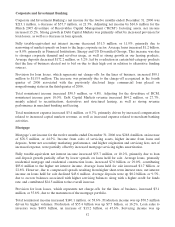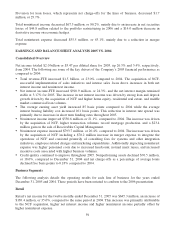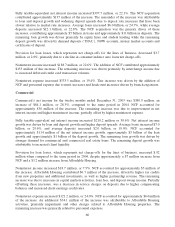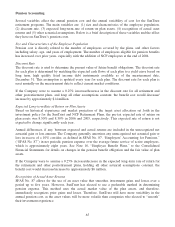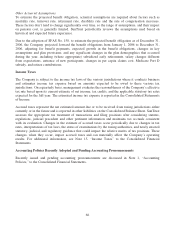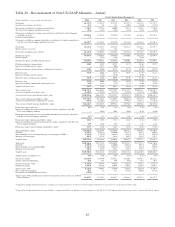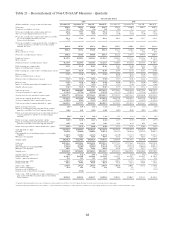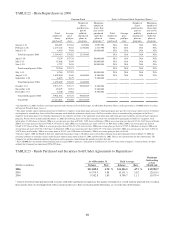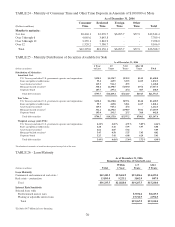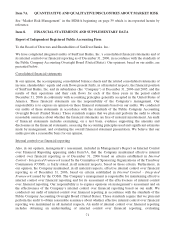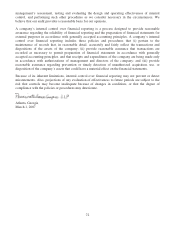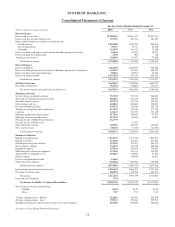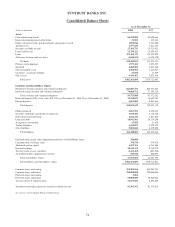SunTrust 2006 Annual Report Download - page 77
Download and view the complete annual report
Please find page 77 of the 2006 SunTrust annual report below. You can navigate through the pages in the report by either clicking on the pages listed below, or by using the keyword search tool below to find specific information within the annual report.The Company’s financial results are impacted by the changes and absolute level of the ALLL. This
process involves management’s analysis of complex internal and external variables, and it requires that
management exercise judgment to estimate an appropriate ALLL. As a result of the uncertainty
associated with this subjectivity, the Company cannot assure the precision of the amount reserved,
should it experience sizeable loan or lease losses in any particular period. For example, changes in the
financial condition of individual borrowers, economic conditions, historical loss experience, or the
condition of various markets in which collateral may be sold could require the Company to significantly
decrease or increase the level of the ALLL and the associated provision for loan losses. Such an
adjustment could materially affect net income. For additional discussion of the allowance for loan and
lease losses see the “Allowance for Loan and Lease Losses” and “Provision for Loan Losses” sections
beginning on page 28.
Estimates of Fair Value
Fair value is defined as the amount at which an asset or liability could be sold in a transaction between
willing parties, that is, other than in a forced or liquidation sale, in a normal business transaction. The
estimation of fair value is significant to a number of SunTrust’s assets and liabilities, including loans
held for sale, financial instruments, MSRs, other real estate owned, other repossessed assets, goodwill,
retirement and postretirement benefit obligations, as well as assets and liabilities associated with
derivative financial instruments. These are all recorded at either fair value or at the lower of cost or fair
value.
Fair value is based on market prices for the same instrument or for similar instruments adjusted for any
differences in terms. If market prices are not available, then fair value is estimated using modeling
techniques such as discounted cash flow analyses. In instances where required by US GAAP, the
Company uses discount rates in its determination of the fair value of certain assets and liabilities such as
retirement and other postretirement benefit obligations and MSRs. Discount rates used are those
considered to be commensurate with the risks involved. A change in these discount rates could increase
or decrease the values of those assets and liabilities. The Company provides disclosure of the key
economic assumptions used to measure MSRs and a sensitivity analysis to adverse changes to these
assumptions in Note 11, “Securitization Activity/Mortgage Servicing Rights,” to the Consolidated
Financial Statements. The fair values of MSRs are based on discounted cash flow analyses. A detailed
discussion of key variables, including the discount rate, used in the determination of retirement and
other postretirement obligations is in the Pension Accounting section.
Fair values for investment securities and most derivative financial instruments are based on independent,
third-party market prices. If market prices are not available, fair values are based on the market prices of
similar instruments. The fair values of loans held for sale are based on observable current market prices.
The fair values of OREO and other repossessed assets are typically determined based on appraisals by
third parties, less estimated selling costs.
Estimates of fair value are also required in performing an impairment analysis of goodwill. The
Company reviews goodwill for impairment at the reporting unit level on an annual basis, or more often
if events or circumstances indicate the carrying value may not be recoverable. The goodwill impairment
test compares the fair value of the reporting unit with its carrying value. If the carrying amount of the
reporting unit exceeds its fair value an additional analysis must be performed to determine the amount,
if any, by which goodwill is impaired. In determining the fair value of SunTrust’s reporting units,
management uses discounted cash flow models which require assumptions about growth rates of the
reporting units and the cost of equity.
64





